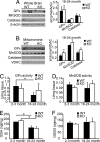DJ-1 gene deletion reveals that DJ-1 is an atypical peroxiredoxin-like peroxidase
- PMID: 17766438
- PMCID: PMC1976193
- DOI: 10.1073/pnas.0703219104
DJ-1 gene deletion reveals that DJ-1 is an atypical peroxiredoxin-like peroxidase
Abstract
Parkinson's disease (PD) is a common neurodegenerative movement disorder. Whereas the majority of PD cases are sporadic, rare genetic defects have been linked to this prevalent movement disorder. Mutations in DJ-1 are associated with autosomal recessive early-onset PD. The exact biochemical function of DJ-1 has remained elusive. Here we report the generation of DJ-1 knockout (KO) mice by targeted deletion of exon 2 and exon 3. There is no observable degeneration of the central dopaminergic pathways, and the mice are anatomically and behaviorally similar to WT mice. Fluorescent Amplex red measurements of H(2)O(2) indicate that isolated mitochondria from young and old DJ-1 KO mice have a 2-fold increase in H(2)O(2). DJ-1 KO mice of 2-3 months of age have a 60% reduction in mitochondrial aconitase activity without compromising other mitochondrial processes. At an early age there are no differences in antioxidant enzymes, but in older mice there is an up-regulation of mitochondrial manganese superoxide dismutase and glutathione peroxidase and a 2-fold increase in mitochondrial glutathione peroxidase activity. Mutational analysis and mass spectrometry reveal that DJ-1 is an atypical peroxiredoxin-like peroxidase that scavenges H(2)O(2) through oxidation of Cys-106. In vivo there is an increase of DJ-1 oxidized at Cys-106 after 1-methyl-4-phenyl-1,2,3,6 tetrahydropyridine intoxication of WT mice. Taken together these data indicate that the DJ-1 KO mice have a deficit in scavenging mitochondrial H(2)O(2) due to the physiological function of DJ-1 as an atypical peroxiredoxin-like peroxidase.
Conflict of interest statement
The authors declare no conflict of interest.
Figures



References
-
- Fahn S, Przedborski S. In: Merritt's Neurology. Rowland LP, editor. New York: Lippincott Williams and Wilkins; 2005. pp. 828–846.
-
- Dauer W, Przedborski S. Neuron. 2003;39:889–909. - PubMed
-
- Moore DJ, West AB, Dawson VL, Dawson TM. Annu Rev Neurosci. 2005;28:57–87. - PubMed
-
- Vila M, Przedborski S. Nat Med. 2004;10(Suppl):S58–S62. - PubMed
Publication types
MeSH terms
Substances
Grants and funding
- NS11766/NS/NINDS NIH HHS/United States
- AG13966/AG/NIA NIH HHS/United States
- NS38377/NS/NINDS NIH HHS/United States
- NS054817/NS/NINDS NIH HHS/United States
- R01 AG021617/AG/NIA NIH HHS/United States
- P50 NS038370/NS/NINDS NIH HHS/United States
- NS16375/NS/NINDS NIH HHS/United States
- R01 AG013966/AG/NIA NIH HHS/United States
- NS38370/NS/NINDS NIH HHS/United States
- ES013177/ES/NIEHS NIH HHS/United States
- AG 21617/AG/NIA NIH HHS/United States
- P30 ES013508/ES/NIEHS NIH HHS/United States
- R21 ES013177/ES/NIEHS NIH HHS/United States
- ES013508/ES/NIEHS NIH HHS/United States
- P50 NS038377/NS/NINDS NIH HHS/United States
- P01 NS011766/NS/NINDS NIH HHS/United States
- R01 NS042269/NS/NINDS NIH HHS/United States
- P01 NS016375/NS/NINDS NIH HHS/United States
- NS42269/NS/NINDS NIH HHS/United States
LinkOut - more resources
Full Text Sources
Other Literature Sources
Molecular Biology Databases
Research Materials

